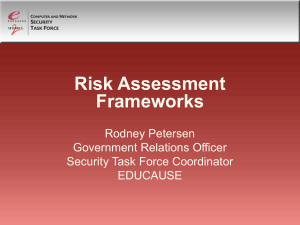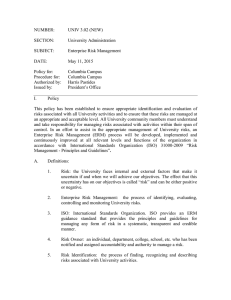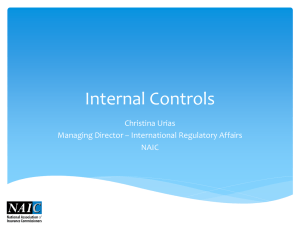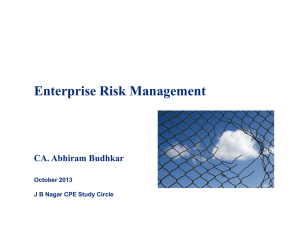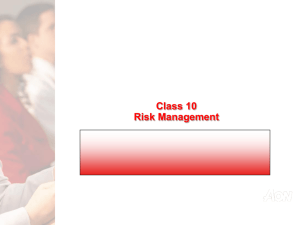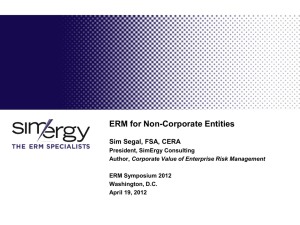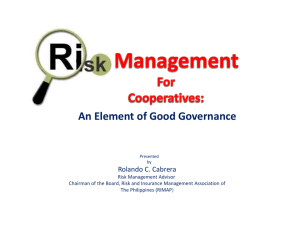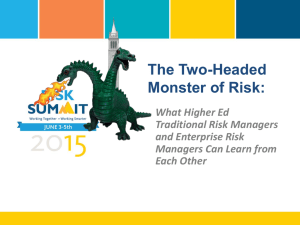concept note on change management and risk management
advertisement
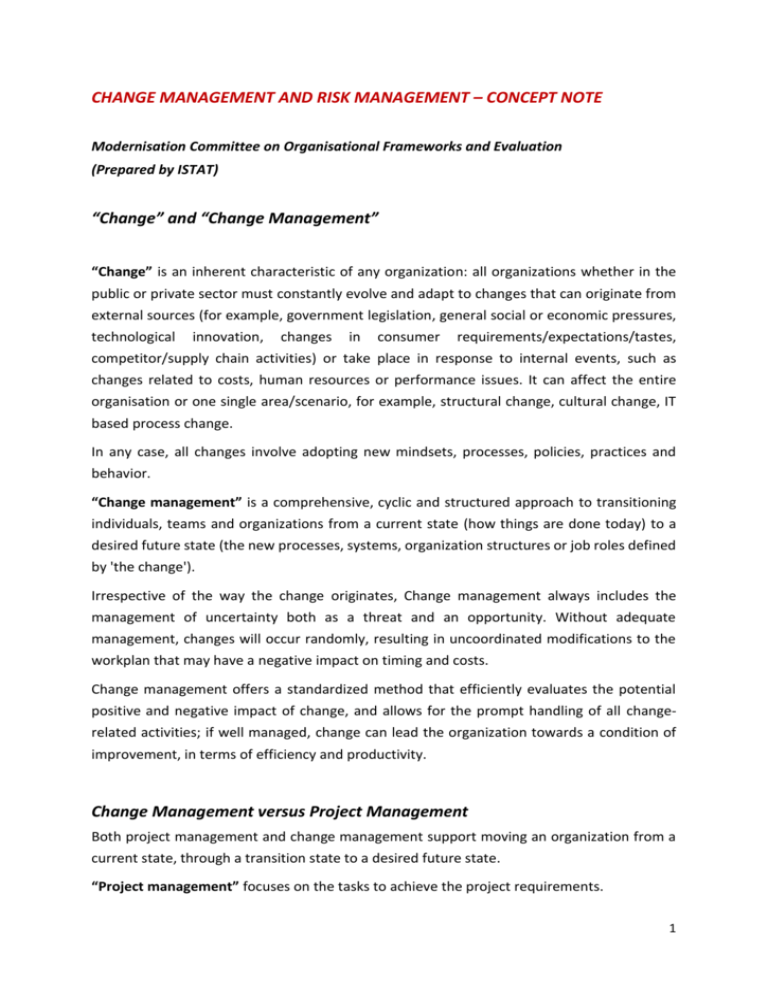
CHANGE MANAGEMENT AND RISK MANAGEMENT – CONCEPT NOTE Modernisation Committee on Organisational Frameworks and Evaluation (Prepared by ISTAT) “Change” and “Change Management” “Change” is an inherent characteristic of any organization: all organizations whether in the public or private sector must constantly evolve and adapt to changes that can originate from external sources (for example, government legislation, general social or economic pressures, technological innovation, changes in consumer requirements/expectations/tastes, competitor/supply chain activities) or take place in response to internal events, such as changes related to costs, human resources or performance issues. It can affect the entire organisation or one single area/scenario, for example, structural change, cultural change, IT based process change. In any case, all changes involve adopting new mindsets, processes, policies, practices and behavior. “Change management” is a comprehensive, cyclic and structured approach to transitioning individuals, teams and organizations from a current state (how things are done today) to a desired future state (the new processes, systems, organization structures or job roles defined by 'the change'). Irrespective of the way the change originates, Change management always includes the management of uncertainty both as a threat and an opportunity. Without adequate management, changes will occur randomly, resulting in uncoordinated modifications to the workplan that may have a negative impact on timing and costs. Change management offers a standardized method that efficiently evaluates the potential positive and negative impact of change, and allows for the prompt handling of all changerelated activities; if well managed, change can lead the organization towards a condition of improvement, in terms of efficiency and productivity. Change Management versus Project Management Both project management and change management support moving an organization from a current state, through a transition state to a desired future state. “Project management” focuses on the tasks to achieve the project requirements. 1 “Change management” mainly focuses on tools and techniques to manage the people-side of change to achieve the required business outcome. More specifically, Change management in the context of project management is a formal process to ensure that any need for changes to the baselines (scope, schedule or cost) are controlled and approved by the proper authority, and communicated appropriately. In order to enable transformation, Change management aligns groups’ expectations, communicates, integrates teams and manages people training. It makes use of performance metrics, such as financial results, operational efficiency, leadership commitment, communication effectiveness, and the perceived need for change to design appropriate strategies, in order to avoid change failures or resolve troubled change projects. Figure 1: Project Management and Change Management It’s goal is to apply a systematic approach to helping the individuals impacted by "the change" to be successful by building support, addressing resistance and developing the required knowledge and ability to implement the change (managing the 'people' side of the change). The underlying basis of change management is that people’s capacity to change can be influenced by how change is presented to them: their capacity to adapt can shrink if they misunderstand or resist the change, causing barriers and ongoing issues. If people understand the benefits of change, they are more likely to participate in the whole process and see that it is successfully carried out, which in turn means minimal disruption to the organization. 2 In addition, change management not only helps ensure that the transition being implemented is successful, it will also help managers diagnose problems with the transition before they become a crisis, and in doing that risk management is a powerful key system. Change Management versus Risk Management “Risk” is an inherent element of change: innovation and changes require risk, therefore every change strategy comes with its own levels of risk; on the other hand, just because change is perceived as risky, often individuals, teams and then the entire organization are resistant to radical change, even as the external environment evolves rapidly. For this reason, certain risks should be allowed and encouraged, but at the same time adequately managed: to mitigate the risk of failure due to organizational issues, adoption of proper change and risk management process, plays a crucial role. Effective change management is interconnected with risk management which minimizes risk of failure and ensures avoidance of unpleasant surprises, both during implementation and post implementation phases. In fact, any change entails risk and the actions aiming at reducing risks are themselves changes; so the relationship between risk and change management is characterized as having circular nature from the beginning. It means that to describe this relationship we can break this circularity at any useful stage of the cycle that could focus on a particular aspect. So we can consider risk management as a part of the wider cycle of change management, according to the following perspective (figure 2). Figure 2: Risk Management in Change Management Next change planning Change planning Evaluation of risk impact on the organization Risk Management in Change Management Risk assessment Response action monitoring Response actions Organizational change + Impact risk reduction 3 Similarly, we consider change management as a component of the risk management cycle. During any activity of an entity, risk management identifies the critical parts of the production and management processes, in order to plan fitting response activities. In this perspective, change management acts as a subsystem of risk management; in fact, to reduce the likelihood of incoming risky events, some changes are expected to be done, especially concerning the phase of treatment during risk management process (figure 3). Figure 3: Change Management in Risk Management Starting point Risk Management Process risk/criticality detection Response action planning = CHANGE PLANNING Criticality reduction/ elimination Change Management Change impact assessment («understanding and controlling the exposure to hazards») Change risk reduction Organization improvement (next point) Risk Management Risks represent uncertain events that could affect the project objectives. This uncertainty is measured in terms of the probability of the risk and the possible impact the threat or opportunity might have on the project. The effect of the event on the project could be either beneficial or damaging. Therefore, risks need to be identified, assessed, and controlled taking into account the nature of the risk itself, the project context and complexity, and the objective at risk; furthermore, adequate responses need to be planned and where the case might require it implemented. 4 In order to manage change, an organization must not only plan and implement an effective and structured process of transition from the present state to a future condition, but it also must be able to rule the uncertainty that is inherent in the process of change, together with its risks and opportunities. The ability to target the change towards a favorable outcome, basically depends on the administration's ability to neutralize the negative factors, which result from a situation of uncertainty and impede the achievement of objectives, and convert them into opportunities. Organizations need to adopt an effective and structured system to manage risks that are inherent into the process of change; therefore, Risk Management must be considered as a tool aiming at implementing the overall Change Management strategy, since it sustains the administration in addressing the transition towards innovation, in order to protect it from potential adverse events that could occur along that path. It is also suitable for support the modernization of business production processes, as it allows to prevent and counteract management inefficiencies, by monitoring and re-engineering procedures and internal control systems in force in the organization. "Risk Management" refers to the coordinated activities that rule and keep under control the administration with reference to risk. It is a continuous and iterative process carried out at different levels of the organization, in order to identify and manage potential risky events and to provide a reasonable assurance on the achievement of the objectives. The risk management process is divided into the following phases: 1. Analysis of the internal and external context. Definition of internal and external parameters to be taken into account when managing risk and setting the scope for risk management policy (external context: cultural, social, political, legal, regulatory, economic, technological, financial, and competitive nature, international and national, regional and local levels, relationships with external stakeholders; internal context: governance, organizational structure, roles and responsibilities, relationships with internal stakeholders, policies, objectives and strategies adopted, etc.). 2. Hazards identification. Detection, recognition and description of risk sources, events, causes and potential consequences; it may include historical data, theoretical analysis, expert opinions and stakeholder’s needs. 3. Analysis and evaluation. Analysis is needed to understand the nature of risk and to determine its own level (risk value). The risk value is given by the product of likelihood of event occurrence and its consequences (impact) with reference to an economic, financial, and reputational perspective. However, evaluation concerns with comparing the results of risk analysis with the risk criteria defined beforehand by the Organization, in order to decide if the risk and/or its size is acceptable or tolerable. Risk assessment is useful to prioritize risk treatment. 5 4. Treatment. Is the process to modify risk and, according to the strategy adopted by the Organization, it can involve: avoiding the risk by deciding not to start or continue with the activity that gives rise to the risk; taking or increasing the risk; remove the risk source; changing the likelihood; changing the consequences; sharing the risk with another party or parties (including contracts and risk financing); retaining the risk informed decision. 5. Monitoring. It refers to control, supervision and continual checking, with the aim of identify differences between the level of performance required or expected and actual one. Monitoring can be applied to specific risks, risk management framework, process, controls and treatment actions. 6. Communication and consultation. It concerns with continuous and iterative process that an organization carry on to provide, share or obtain information and to engage a dialogue with stakeholders and other parties regarding the management of risk. While Change Management can be considered a comprehensive approach, fitting to provide an overall strategy to manage the organizational set-up change, Risk Management is a tool complying with the best European and international practices oriented to the modernization and standardization of production processes (such as GSBPM – Generic Statistical Business Process Model), since it represents a good example of organizational and managerial innovation that engages the administration as a whole. It is grounded in international standards, the most qualified of them include ISO 31000 : 2009, UNI 11230 : 2007, ISO/TR 31004 : 2013, ISO/IEC 31010 : 2009 and the Enterprise Risk Management (ERM), published in 2004 by Committee of Sponsoring Organizations of the Treadway Commission (CoSO)1. 1 ERM is based on Internal Control-Integrated Framework, the international standard and best known for the system of internal controls, published in 1992. The latest updates of the standard are the COSO ERM – Internal Control – Integrated Framework (2011) and COSO ERM – Executive Summary (2013). 6
